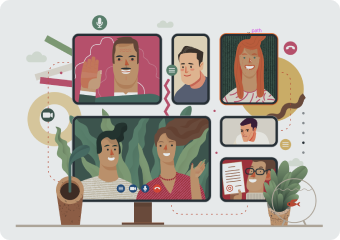

The pandemic has redefined work and the workplace. Work from home to work from anywhere is the global mantra. Should a company embrace the concept of hybrid workplace, go digital all the way or start calling employees to work in a phased manner? How can technology enable the new workforce in the new found work spaces? Read on to know more.
As an event that has affected every human being, COVID-19 is a watershed moment in the development of our society. With our innovation outpacing evolution, changes to culture represent changes to the human experience, and with workplaces, the pandemic has proved transformative. Despite their resources, agility and flexibility, can organizations adapt to a new paradigm of workplace models? What are the most significant developments and challenges organizations must address? How will talent and technology drive this shift?
In this conversation with Mukul Pandya and Kisha Gupta, we explore these questions from the viewpoint of industry, talent, research, and perhaps most compellingly, the interviewees’ subjective context.

Editorial Team: The world has changed, and so has the “world of work”. What are the most prominent developments in the COVID and post-COVID world?
Kisha: COVID-19 has changed the social nature of work. We can travel for leisure, but not to the office. Organizations won’t push for a complete return, given the potential fallout from the risk of something going wrong. It’s great that we have been able to adapt, but I believe we’re on the cusp of rediscovering the charms of the old normal while being aware that some aspects have changed.
When COVID-19 happened, the optimist in me expected a temporary change. However, when I see it unfolding, there is a significant number who do not want to return. The people who started pre-pandemic are open and pretty bullish about a hybrid situation combining remote and in-person work. The ones who began work during the pandemic, however, may not see the need to come to work. That strikes me as odd because the latter has met nobody at work. Relationships are valuable. The reason our organization, for instance, could move faster is that everyone knew and trusted each other.
Mukul: I agree with Kisha. The nature of work was already changing before the pandemic. COVID-19 accelerated this transformation, notably the dramatic increase in remote work. Let me address it from the context of learning and education, given my experience in that area. Remote learning through Massive Open Online Courses (or MOOCs) was already growing via platforms such as Coursera, Udacity, or EdX. Many universities offered these online courses via these platforms, but they were peripheral to the primary pedagogical model, which was still based on on-site learning on college campuses. Almost overnight, universities had to pivot to remote learning for all classes. Many of these changes will probably continue in the post-COVID world. Once the genie is released, it won’t go easily back into the bottle.

Editorial Team: How do you think these transitions and transformations will impact the organizations in the medium-long term?
Mukul: Hybrid work has been in the mainstream for some time now, just not at this scale. Nicholas Bloom at Stanford University’s Institute for Economic Policy Research wrote in June 2020 that 42% of US workers were working from home full time. This shift accounted for more than two-thirds of economic activity, a non-trivial amount by any measure.
Teams accustomed to working like this found it easiest to adapt. Here, I want to give you the example of the Knowledge@Wharton team I used to manage. Knowledge@Wharton is an online publisher. In the past years, whenever there was a snowstorm, people couldn’t travel to the university. So we were already used to sitting at our desks at home, getting on conference calls, and doing whatever we needed to publish our edition, once a week and later twice. The internet is, after all, meant for distributed work.
Kisha: It is a substantial change that has both advantages and limitations. The good news is that our interns have adapted well and learned to live with it. They have shown resilience and ingenuity, from exploring new ways to interact with people and build relationships to taking charge of their learning and managing work.
Our interns are currently working on problems particularly relevant to their location, so while the global experience has changed, the local impact has deepened. The inability to visit India, on the other hand, takes away from the visceral experience of visiting a country so unique and stimulating, which a virtual experience can’t replace. So, although I am grateful for the safety and adaptability possible for many of us, the comfort and restrictiveness of the current environment can also stunt personal growth.

Editorial Team: What is your view on remote work, and how has it influenced talent acquisition and employee engagement?
Mukul: As I mentioned in the example of the Knowledge@Wharton team, remote work favours some types of work over others. Managers, professional service sector workers, finance workers, and others with broadband connectivity could use platforms like Zoom, Microsoft Teams, or Google Meet and adapt to remote work quickly, but in other fields like travel, food services, or health care, remote work cannot easily substitute for on-site work. These factors have a significant impact on talent acquisition. If you are engaged in work that lends itself to being done remotely, you have access to a broader talent pool than you might have had in the past.
Employee engagement is a more complicated question.
We cannot escape the consequences of this productivity-driven culture unless it develops empathy and a conscience.
Kisha: Remote work has its advantages for organizations, including the cost of physical facilities, infrastructure, and maintenance. Access to a broader talent pool is also another benefit. The pillars of a good relationship—loyalty, connection, respect, and shared purpose—are the actual markers of employee engagement. A strong culture can help you attract and keep people by reinforcing these pillars, but building one is more difficult now than before. For inspiration, we should look to companies that have been remote by choice, even before the pandemic, to understand how they built and ensured a strong culture across a distributed workforce. One aspect that stood out to me about such firms was their commitment to transparency at every level—scope, salary, growth, and acceptable standards of behaviour. Developing specific guidelines for each of those parameters before communicating them to employees across the organization is a crucial imperative alongside ensuring the highest standards of inclusivity.
Editorial Team: How can organizations approach the question of remote work, hybrid work, or returning to the office? What aspects must they consider?
Kisha: In the short term, from what we have seen, and it’s hard to look too far into the future, given how fast the situation is changing, the shift in work paints a rosy picture for organizations. People are productive while working away from home, and companies save substantial amounts on infrastructure maintenance costs and other operational expenses. So, from that lens, you could say things are going well. However, it’s safe to say that the decay of organizational social fabric is firmly underway and must be addressed urgently.
Mukul: There are a few key aspects to consider as organizations think about hybrid work, not just where to work but also when to work. First, the definition of the workday is changing from the old notion of 9 to 5. This shift is especially true of people who work across multiple time zones. Whether organizations can balance efficiency, effectiveness, and uniformity remains to be seen, but this balance matters in any business decision.
The fact is that employees recognize the issues of the old model of working and want the change to develop into something congruent with their needs. Slack conducted a global survey of knowledge workers about a year ago, and its findings confirm this desire for a transition. According to the CEO, Stewart Butterfield, “Our Future Forum research of 4,700 knowledge workers found the majority never want to go back to the old way of working. Only 12% want to return to full-time office work, and 72% want a hybrid remote-office model moving forward.”

Editorial Team: Much has been said about its advantages, but what are some pitfalls of remote work?
Kisha: Virtual working can see people lose their influence in the workplace or at least hamper their ability to build it. Trust is such an essential component of work, and it is challenging to earn virtually. Perceptions constructed entirely on limited online interactions present a skewed view of people. Another aspect to consider is the redundancy of carefully developed environments and physical infrastructure. Office spaces, buildings, and training centres represent billions of dollars in investments, all of which face obsolescence in an entirely digital scenario. These aspects lead me to believe that we need a hybrid of context, environment, and mindset.
Mukul: It may be helpful to think about the pitfalls of remote work from two perspectives: employer and employee. Peter Cappelli, a professor of management at Wharton and the director of the school’s Center for Human Resources, has written a timely book about this—The Future of the Office: Work from Home, Remote Work, and the Hard Choices We All Face—that I would recommend to readers of The Edge Quarterly. In this book, Cappelli writes that there is no consensus about handling remote work policies among employers. This divergence of views, combined with the resurgence of COVID-19’s new variants, has forced companies to postpone deadlines for bringing people back to offices, which has meant that almost all companies seem to be waiting to see what others will do.
People tell funny stories about children wandering in while a parent is at a video conference – but there’s a sadness to such reports. What happens if children are neglected because work never seems to stop? Then there is the issue that faces hybrid work specifically—the divide between people who work from home and those who go to the office.
These are intangible costs that companies might overlook because they are difficult to measure, but for that very reason, they are critical. Even with a return to work, organizations have to fight several challenges, none more critical than offering employees the ability to rest, learn, recover, and reset.

Editorial Team: People are moving to less expensive areas given the ability to work remotely. Is this affecting pay? Since the value of the work hasn’t changed, should it?
Kisha: It should not, but the question is more nuanced than that. One view is that the cost of living of a location should play a part in the remuneration, which is understandable. However, if I choose to work from multiple locations, will organizations calculate the cost of living of each area and offer a tiered salary? That seems impractical. I believe companies should set wages based on the role and not the location.
Mukul: I find this a disturbing trend, and one that I have heard about from friends who work in the Bay area near San Francisco. However, when workers work in remote locations where real estate is less expensive, and thus the cost of living is presumably lower, some companies are reducing annual pay increases or even imposing pay cuts. Another trend to which we should pay attention is the tendency of some countries, especially those with a robust digital infrastructure, to attract digital nomads. Estonia, for example, has created a digital nomad visa to attract such workers. It lends an interesting dimension to the global war for talent.
Editorial Team: Does technology have a role to play in this transition? What can it do?
Mukul: To me, the issue of remote and hybrid work is a human issue.
Technology can help drive productivity, but as the report above said, that may come at the cost of adding to exhaustion. Relaxation is crucial for creativity and overall well-being. No amount of wealth–whether 500% pay hikes or increases in wealth from stock options as technology stock prices rise-can compensate for long-term damage to mental and physical health. I see that as a considerable risk. I hope technology leaders will pay attention to this issue.
Kisha: Technology can enable inclusion. It allows us to tap into talent pools previously inaccessible and expand our hiring to new geographies. Another aspect of technology is its ability to drive extreme efficiency and focus humans on value-driven tasks.
Nothing will change that.
Editorial Team: Who owns technology adoption for workplace strategy? Does it sit with IT, company leadership, or HR? What can each of those functions do to make a case for tech-driven employee engagement?
Kisha: In a services organization, it would be best owned by one department-agnostic leader. A siloed approach, either with IT, marketing, or HR, won’t work because these departments just weren’t built for this specific purpose. Since it’s a new objective, organizations should create a specialized role with clear goals and then appoint a team governed by a department-agnostic leader focused on strategy and internal communication, implementation, and change management. Listening will be an essential part of this role, especially the ability to separate signal from noise. Other aspects of the mandate would be running pilots fast, being open to failure, and getting results to improve the process. Incubating ideas without action is just not going to work.
Loved what you read?
Get practical thought leadership articles on AI and Automation delivered to your inbox
Loved what you read?
Get practical thought leadership articles on AI and Automation delivered to your inbox
Editorial Team: What are your recommendations for organizations looking to adapt to this scenario?
Kisha: Assuming you have to adapt to the way things are today, focus on radical transparency. Tell people what they need to do, what impact their work will have, and where achieving their goals will take them. This need for transparency is especially true for mid-size and small firms that can’t buy their way into better talent pools.
Mukul: Stay on top and keep studying these issues. A lot of experts are writing about them, and they don’t necessarily agree with one another. If handled correctly, remote and hybrid work can have many positive effects – flexibility, productivity, and employee satisfaction. But there are equally severe problems involving pay equity issues or the inequality time bomb. My first recommendation is that organizations should address these issues thoughtfully and with emotional intelligence. Empathy needs to become a crucial component of every company’s culture. Second, focusing on optimising work at the activity level, not just the role or location level, might be a better lens to use when redesigning work structures. Finally, as difficult as it may be, employers should consider individual employee needs instead of a blanket approach. People have different lives and contexts, and their work should consider the uniqueness of their circumstances.
Editorial Team: What are the risks of ignoring the need for change?
Kisha: Companies should understand their unique context and make changes, if necessary, accordingly. The reality is that no one has cracked a formula, but that’s no excuse to avoid trying. I don’t believe in drastic predictions and see the situation as an opportunity to evolve. A fear-led mindset will only offer survival tactics. Enterprises that respond with innovation, ingenuity, and empathy will earn a compelling competitive advantage. That is the benefit.
Mukul: Companies can’t just be bottom-line oriented. The risk of not adapting to change when it is warranted is that it will hit the wallet. That’s the issue at the heart of the matter. Companies guilty of clutching onto one revenue stream because it has worked in the past, without considering the need to create others, are likely to be in a spot of bother. Competition is already and will continue to be disruptive. Countries otherwise unheard of in this context are emerging in the race for global talent, as are innovative ways of working and brand-new roles. For organizations, the risk of ignoring the need for change is death by obsolescence. Life is not going to wait. That’s the bottom line.
Disclaimer Any opinions, findings, and conclusions or recommendations expressed in this material are those of the author(s) and do not necessarily reflect the views of the respective institutions or funding agencies






